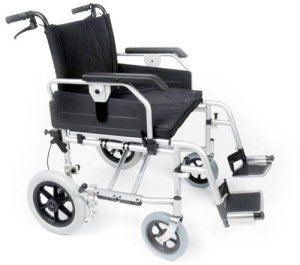Bariatric Wheelchair Seat Width
Seat Width
Having the proper seat width is very important to wheelchair users who spend longer durations in their chairs. Too narrow a seat will trigger pressure on the hips and thighs which might lead to sores or pressure points. Having too wide a seat can likewise make it challenging for the user to reach the hand rims to propel themselves or maneuver in small spaces.
To measure the appropriate seat width a person would sit on a chair generally and have their measurement taken throughout their lap at the best point which is normally their hips. A wheelchair determining tape can be utilized to measure this, but a yard stick is chosen as it prevents people from covering the tape around their hips which would offer an unreliable result.
The standard wheelchair seat width is 16" (narrow grownup), 18" (standard grownup), and 20" (broad grownup). For bariatric patients, a 24" seat is available. This sturdy additional large bariatric wheelchair from Medline features swing-away footrests, a carbon steel frame with rust- and chip-resistant chrome plating, and easy-to-clean vinyl upholstery. It has a weight capacity of 500 pounds.
Seat Depth

Typically, the seat depth of a bariatric wheelchair was included 2" to the measurement taken at the user's widest point (generally their hips). This was meant to accommodate additional layers of clothes that might be used throughout cold weather condition. Nevertheless, this practice is becoming less typical as wheelchair users are able to invest more time indoors and are not wearing long coats. This makes the seat depth of a chair lesser when selecting a bariatric wheelchair. Nevertheless, it is still important to choose a choice that offers appropriate support for bigger users.
The Medline folding additional large bariatric manual wheelchair includes a comfortable 24" seat width and a durable slide tube silver vein frame. It also has an adjustable axle and tool-free raising legrests.
Seat Height
When it concerns determining the correct wheelchair seat width you should constantly determine from the user's widest point which is normally their hips. You will also need to consider whether the user is going to be wearing a winter season coat as this may include 2" to the width needed.
When a wheelchair remains in usage it should just be run on level surface areas with the wheel locks totally engaged. This is to avoid the chair from having the ability to move inclines that are 10 degrees or greater. It is also important to bear in mind that any activity that might shift the center of gravity in the chair ought to be made with care. This consists of reaching for products that require the individual to lean out of their seat or trying to stand from it.
Whenever you have the chair in use it is suggested that you frequently examine it for damage and oil any locations that are deemed necessary. For instance, the casters should be lubed by removing the caster fork and using a multi-purpose grease to use to the caster stem bearings. Also, the foot plates can be adjusted by loosening the bolt and after that moving them to the desired position. This allows the feet to sit comfortably on the footplate and prevents any pressure points from forming. This can be extremely unpleasant for the user and if left ignored, can lead to pressure sores.
Weight Capacity
Bariatric wheelchairs are created to support more weight than basic wheelchairs. This makes them sturdier and better equipped to handle falls. They are likewise usually bigger and broader, making them less maneuverable in tight spaces than basic wheelchairs. They require automobiles with special ramps and lifts to fill them, along with chauffeurs who know how to best transport them from one location to the next.
When choosing bariatric wheelchair recliner , consider its weight capacity as it will be the main determining consider whether it will accommodate your traveler's needs. The weight capacity of the chair is frequently listed as a fixed load, indicating that it suggests the quantity of weight the chair can easily hold while standing still. However, some manufacturers likewise note an active load that is based upon a drop test and can imitate the result of someone taking a seat in the chair. This may be a more reliable measurement of the weight limit, depending upon your needs.
If you plan to carry out activities that move your center of gravity in the seat (such as reaching for items), make sure to have front casters pointed in a forward instructions and wheel locks engaged so the chair will not topple. Likewise, check that casters are lubricated frequently to prevent excessive wear and abrasions. The lubrication procedure includes getting rid of the fork, separating the caster from the wheel, and greasing the caster stem bearings with top quality multi-purpose grease.
